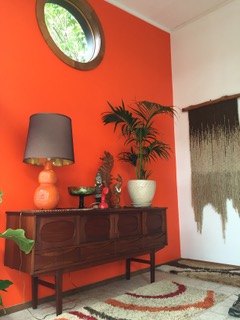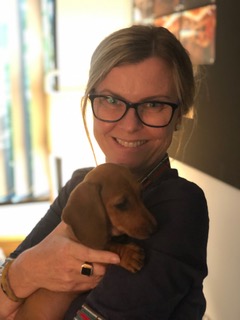
You may not have heard Justine Dunn’s name, but chances are that you have seen and admired her work. Her Art Department credits include diverse titles, Crazy Rich Asians (2018), Thor: Ragnarok (2017) and Anna and the King (1999) among them. She has been a set decorator, props master, and senior buyer for major films and acclaimed television series’. The artist played a major role in bringing the world of Orphelin Bay to life in the Netflix series Tidelands (2018). Dunn, and the entire creative team, portrayed the gritty, working-class fishermens world against the glamorous mystery of the island L’attent. The thread of folklore, and a romantic web, hung between the two settings in the script and in the visual design. Learn more about Justine Dunn and her work on Tidelands in our Q&A below.
How did you get into the world of production design?
Originally, I studied for a Bachelor of Arts in Theatre at Queensland University of Technology and specialized in Stage Design in my final year. As part of my course we had to participate in work experience, which lead me into the world of TV commercials where you have 30 seconds to tell your visual story. The planning and detail of every shot by the Art Director and Director of Photography was fascinating. I didn’t even know such a job existed. After a short stint in the TV commercial world, I realized I was more interested in the bigger, more meaningful stories of Film and TV Series where you can develop whole worlds based around the script and its characters.

What drew you to scenic design?
The Production Design and Set Decoration roles are part of the story telling process. I have worked in many different roles that fall under the Art Department umbrella – On-Set Standby Props, Props Master, Buyer – but through Set Decoration we can build on a character’s background with the things we place around them in the set. The set decoration and background set should complement the story with colour choices, fabric, wallpaper and textures, lighting, furniture choices etc. For example a film set in the 1800’s will be researched for appropriate examples of what we know about the character i.e : age, occupation, gender, class, family history, Nationality, economic status. But if we don’t have much information from the script, we create a backstory that helps us make the creative decisions for each set.

Describe your most memorable projects:
“Anna and the King”
filmed in Malaysia in 1999, starring Jodie Forster and Chow Yung Fat. Designed
by Luciana Arrighi, it was nominated for an Academy Award in Production Design.
It was the first film that I had worked on that was on such a grand scale, but
still with amazing attention to detail. With the restrictions of filming a story set
in Thailand, but actually building the film sets over the border in Malaysia (a
very different aesthetic and culture from Thailand), 1000’s of extras,
elephants carrying actors, dinner parties for 300 people, it was epic. We had
to smuggle statues of Buddha over the border into Malaysia for filming, as we
had to re-create the Emerald Buddha Temple for the final scene of the film. I
was based in Thailand as the Props Buyer, sending props and dressing by the
truck-load over the border into Malaysia. I used to spend every Saturday with a
wad of cash the size of a house brick at the ChutuChut Markets looking for
fabrics, carvings, furniture, ceremonial and religious items, lighting, boats …


If you could live in one of the sets that you’ve worked on, which one would you choose?
Great question and I often think about that when I’m working on a set ‘What would I do if I was living / working / hiding here?’ Probably the Jones House in “Swinging Safari” (2018). It was a cool party pad with sunken lounge and shag-pile carpet. It had a massive deck and a pool and a great record collection.

“Tidelands” premiered on Netflix here in the United States last December. You were a part of the production team. What was the creative vision for “Tidelands” before the show came to fruition?
It was writer Stephen Irwin who came up with the story and concept. We were given a detailed character breakdown, which gave us a lot of history and backstory for a realistic, grounded approach to a fantasy genre. Production Designer Matt Putland and I wanted to create a world that felt like the Tidelanders could have been living amongst us for centuries unnoticed. The actual commune of L’attent, we wanted to feel historical, symbolic and have strong links to the sea and water. We wanted the rest of Orphelin Bay to be grungy and look functional, like the Devil’s Tail, Bill’s Boat, and the Fish Co-op.


Is the premise of the show based on a particular myth or legend?
It is a world created from the imagination of Stephen Irwin (the Writer and Co-Producer) then fleshed out with the input of Tracey Robertson, Nathan Mayfield and Leigh McGrath from Hoodlum Productions. Because Stephen is a novelist, he wrote the backstory for us and we received an extensive dossier of the Tidelanders history.
The set is very imaginative. L’attent (the island where the sirens live) could have been a cliche beach-y design – all tan and turquoise. Instead, the island feels like an otherworld. Adrielle’s house on the island is a very rich setting. Lots of velvet and dark wood. What was the inspiration for this?
We wanted to show a history and tradition of the Tidelander people. So, we wanted the house to be historic, not modern. The colour palette was a selection of sea greens and dark, inky blues with flashes of silver, like an underwater effect. We placed water elements throughout the set and used all practical lighting which always looks moody against the glossy dark wood. We knew there was going to be a lot of bloodshed…

How long did it take to create Adrielle’s house?
From construction drawing to completely dressed…9 weeks and that is 3 different departments with slight crossover: Construction, Scenic, then Set Decoration.
Where did the inspiration for the stainedglass window come from? Also, who made it?
Matt Putland oversaw the Design Assistant Stephanie Brooke, who drew it by hand then transferred it to digital. It was symbolizing the matriarch of the Tidelands with her people at her feet. It was actually printed onto vinyl in full scale then transferred to glass, each section stained individually, then edged with a substitute to look like lead-light. It had to be reworked a few times as one of the first versions was ‘too busty’ …LOL !
What was your favourite feature on the set of “Tidelands”? Furniture, wall color, etc.
Definitely the sparkly wallpaper (From Zepel Fabrics) in the Foyer of Adrielle’s house… but I also really loved the 5m drop waterfall drapes in the main hall …and the bespoke resin filled dining…and …

Follow @justdunnthis on Instagram to learn more about her work and see behind-the-scenes images from Tidelands and her other projects.